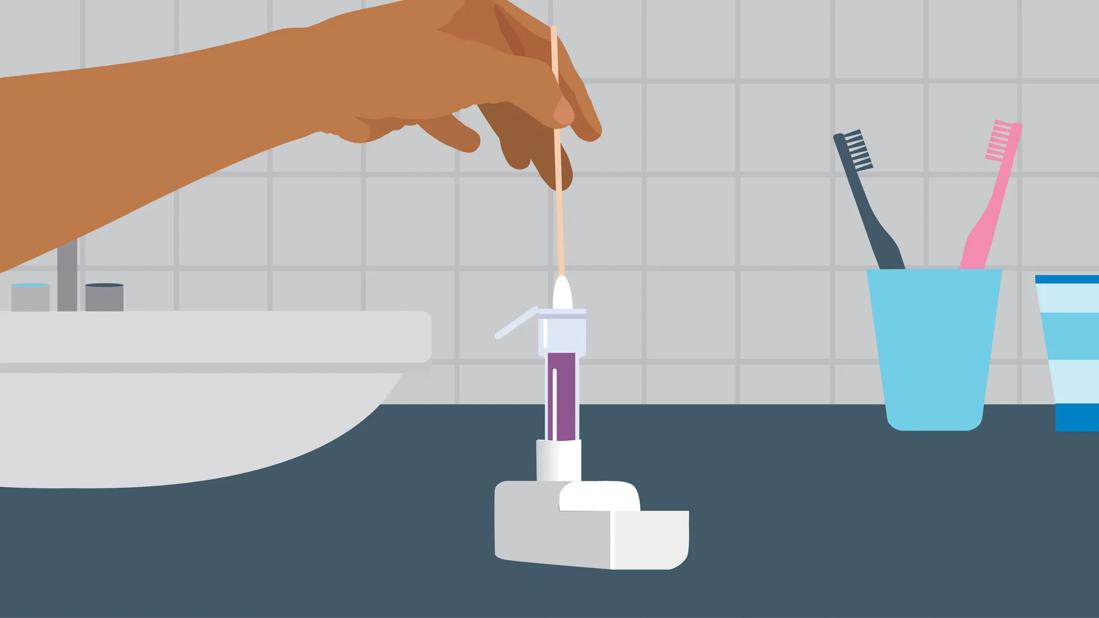This at-home test for COVID-19 and flu can help you figure out what’s causing your symptoms, and how best to treat them

Your body aches. Your nose drips. It hurts to swallow. And that tickle in your throat is causing a cough that won’t quit.
Advertisement
Cleveland Clinic is a non-profit academic medical center. Advertising on our site helps support our mission. We do not endorse non-Cleveland Clinic products or services. Policy
You know these signs can indicate more than an average cold. But do you have COVID-19, the flu or something else?
“Even medical experts don’t rely on symptoms to discriminate between causes of viral illnesses like COVID-19 and the flu,” says microbiologist and pathologist Daniel Rhoads, MD. That’s because COVID-19 and the flu cause similar, overlapping symptoms. Plus, other respiratory viruses can also cause flu-like symptoms.
So, what are you to do when you’re feeling sick and you’re not sure what’s behind your illness? Now, a newly authorized, over-the-counter (OTC) combination test for COVID-19 and flu is making it easier to figure out what ails you — all from the comfort of home.
In February 2023, the U.S. Food and Drug Administration (FDA) issued an emergency use authorization for the first (and so far, only) combination OTC test kit that checks for the distinct viruses that cause COVID-19 and flu. The rapid Lucira® by Pfizer COVID-19 & Flu Home Test provides results in 30 minutes.
The Lucira by Pfizer test works differently from the home tests you may have been using. “Until now, at-home COVID-19 tests were antigen tests,” says Dr. Rhoads. “These tests look for specific antigens, or proteins, that coat the coronavirus.”
Advertisement
Lucira by Pfizer is a molecular test. It checks for ribonucleic acid (RNA) molecules unique to the:
It’s accurate but not perfect. According to the FDA, a clinical study showed the Lucira by Pfizer test:
From a user perspective, the combination COVID-19 and flu test works like other at-home COVID-19 tests. You swab both nasal passages with a provided nasal swab and swish the swab around in a vial.
But there are some differences. The combo test has a battery-operated device that spins the sample, separating and identifying the virus molecules.
Even if you feel like you’re an ace COVID-19 test taker, it’s important to read through each step of the instructions that come with the Lucira by Pfizer test kit before you start. “Directions can vary by test, and manufacturers often make updates,” clarifies Dr. Rhoads.
Currently, the Lucira by Pfizer test requires three steps:
People 14 and older can perform the test themselves. Adults should test children between 2 and 13 years old.
Test for COVID-19 and the flu as soon as you have symptoms, advises Dr. Rhoads. “Symptoms indicate your body has recognized an infection is underway and you could be actively shedding the virus — and that would be contagious.”
You can buy the combination at-home COVID-19 and flu test at your local drugstore or online. The Lucira by Pfizer test typically costs between $40 and $50. You may be able to purchase the test with funds from a Health Savings Account (HSA). You can also contact your health insurer to see if they’ll reimburse you.
It depends on how sick you feel and if you have conditions like asthma or heart disease that put you at risk for serious illness or hospitalization. “Antiviral medications for COVID-19 and influenza antiviral medications can lessen symptom severity, lowering your risk for hospitalization,” says Dr. Rhoads.
Advertisement
Antivirals work best when taken within 48 hours of symptoms starting. This is another good reason to use the combination test: You’ll know which virus you have, so you can get the right medicine.
If you’re low risk for complications and have mild-to-moderate symptoms, these steps can protect others from exposure and relieve your symptoms:
Sort of, but it’s a bit more involved and doesn’t give you immediate results. Pixel from Labcorp is the only FDA-approved self-collected test for COVID-19, flu and respiratory syncytial virus (RSV). These three respiratory viruses cause similar symptoms. But there are differences, including who’s most at risk and how providers treat them.
The 3-in-1 test isn’t available in pharmacies. You need to order the kit online (but you don’t need a prescription). When the kit arrives, follow the instructions to do the test. You then mail the nasal swab sample back to the laboratory for testing and get results in a couple days. The $129 test is approved for ages 2 and older.
Advertisement
With flu season approaching and COVID-19 peaking around the same time, at-home tests make it easier to pinpoint the cause of your symptoms in real time. The bonus: Increasing your awareness about your symptoms and what’s causing them likely will reduce your chances of exposing others to the same infections.
Advertisement
Learn more about our editorial process.
Advertisement

Most can return to work or school when they’re symptom-free for 24 hours

Covering your mouth when you cough and staying home when you’re sick are a couple ways to help keep yourself and others COVID-free

This vital nutrient supports your health, but its role in COVID-19 prevention and treatment isn’t proven

Studies have shown promising results, but additional research is needed

Infection and inflammation can cause you to lose your voice and have other voice changes until you’re fully healed

A COVID-19 infection can bring on depression or anxiety months after physical symptoms go away

Just like the flu, COVID-19 continues to evolve every year with new and smarter variants

The latest omicron subvariants carry specific mutations that may allow the SARS-CoV-2 virus to be better at evading immune protection

You can improve your athletic performance over time by breaking up your workout regimen into focused cycles

The little blue pill might help with physical arousal, but there are better treatments for low libido in women

Sleep issues and certain foods can lead to an early morning headache